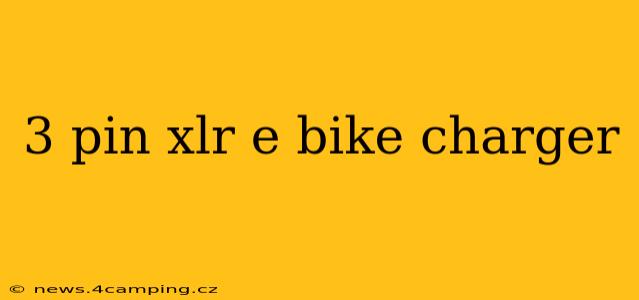Finding the right charger for your e-bike is crucial for its performance and longevity. This guide focuses specifically on 3-pin XLR e-bike chargers, covering their features, compatibility, safety, and troubleshooting. Understanding these aspects will help you choose the best charger and maintain your e-bike efficiently.
What is a 3-Pin XLR E-Bike Charger?
A 3-pin XLR e-bike charger utilizes a 3-pin XLR connector to deliver power to the e-bike's battery. XLR connectors are known for their durability and reliable connection, making them a popular choice for various applications, including professional audio equipment and, increasingly, e-bikes. The charger itself converts AC power from your wall outlet into the appropriate DC voltage and current required by your e-bike's battery pack. The number of pins (3 in this case) determines the configuration and functionality of the charger. While a simple 2-pin setup might suffice for less demanding applications, a 3-pin connector often includes features like ground wires for improved safety and potentially additional communication signals.
What are the Different Types of 3-Pin XLR E-Bike Chargers?
The primary variation you'll encounter with 3-pin XLR e-bike chargers lies in their voltage and amperage output. These specifications must match your e-bike battery's requirements precisely. Using an incompatible charger can severely damage your battery or even pose a fire hazard. Pay close attention to the voltage (e.g., 48V, 36V, 24V) and amperage (e.g., 2A, 3A, 5A) printed on your e-bike's battery and charger. Higher amperage generally translates to faster charging times, but always prioritize compatibility over speed. You'll also find variations in the charger's physical size and design, influenced by factors like power rating and internal components.
How Do I Choose the Right 3-Pin XLR E-Bike Charger?
Choosing the correct 3-pin XLR e-bike charger is paramount. Improper charging can lead to reduced battery lifespan, performance issues, or safety hazards. Always:
- Check your e-bike's manual: The manual should clearly specify the required voltage and amperage for your e-bike's battery.
- Identify the connector type: Ensure the charger uses a 3-pin XLR connector that is compatible with your e-bike's charging port.
- Match voltage and amperage: The charger's voltage and amperage must exactly match those specified in your e-bike's manual. Using a charger with higher voltage is extremely dangerous. A charger with slightly lower amperage will simply charge slower, but a charger with higher amperage could damage your battery.
- Consider charging time: Higher amperage chargers generally charge faster, but this often comes at the cost of increased heat generation.
What are the Safety Precautions for Using a 3-Pin XLR E-Bike Charger?
Safety should always be your top priority when dealing with electricity. Here are some crucial safety precautions:
- Only use the charger provided by the manufacturer: Using an incompatible charger is extremely dangerous and can lead to fire or serious injury.
- Inspect the charger regularly: Check the cable for any signs of damage, such as fraying or exposed wires.
- Do not charge the battery in extreme temperatures: Avoid charging in direct sunlight or in excessively cold environments.
- Never leave the charger unattended during charging: Monitor the charging process to ensure it is proceeding correctly.
- Unplug the charger after charging is complete: Leaving the charger plugged in unnecessarily can put stress on the battery and the charger itself.
How Do I Troubleshoot a 3-Pin XLR E-Bike Charger?
If your 3-pin XLR e-bike charger isn't working correctly, there are several troubleshooting steps you can take:
- Check the power outlet: Make sure the power outlet is working correctly by plugging in another device.
- Inspect the charger cable: Look for any signs of damage or loose connections.
- Check the connector: Ensure the 3-pin XLR connector is securely plugged into both the charger and the e-bike.
- Check the battery: Make sure your e-bike battery isn't faulty or damaged. Consider testing it with a known good charger if possible. A multimeter might help test voltage.
If you have tried these troubleshooting steps and your charger is still not working, it's best to contact a qualified technician or the e-bike manufacturer for assistance.
Are there any alternatives to 3-Pin XLR E-Bike Chargers?
Yes, other connector types exist for e-bike charging. Common alternatives include DC barrel connectors, Anderson Powerpoles, and various proprietary connectors specific to certain e-bike brands. These connectors offer similar functionality but may have differences in size, durability, and amperage capacity. The choice depends on the e-bike model and manufacturer.
This comprehensive guide provides a solid foundation for understanding 3-pin XLR e-bike chargers. Remember to always prioritize safety and consult your e-bike's manual for specific instructions and recommendations. By following these guidelines, you can ensure your e-bike battery is charged safely and efficiently, extending its lifespan and maximizing your riding enjoyment.
